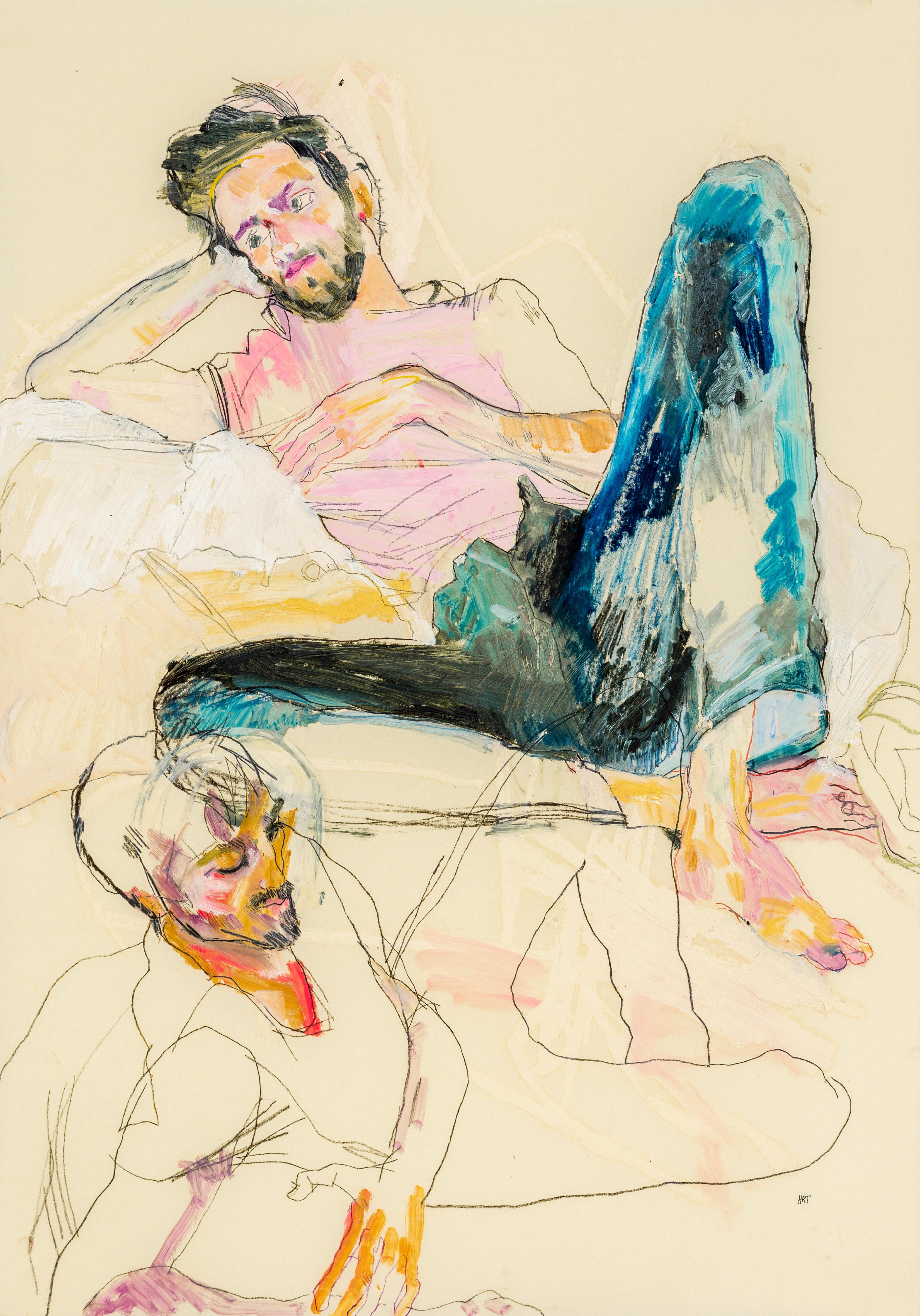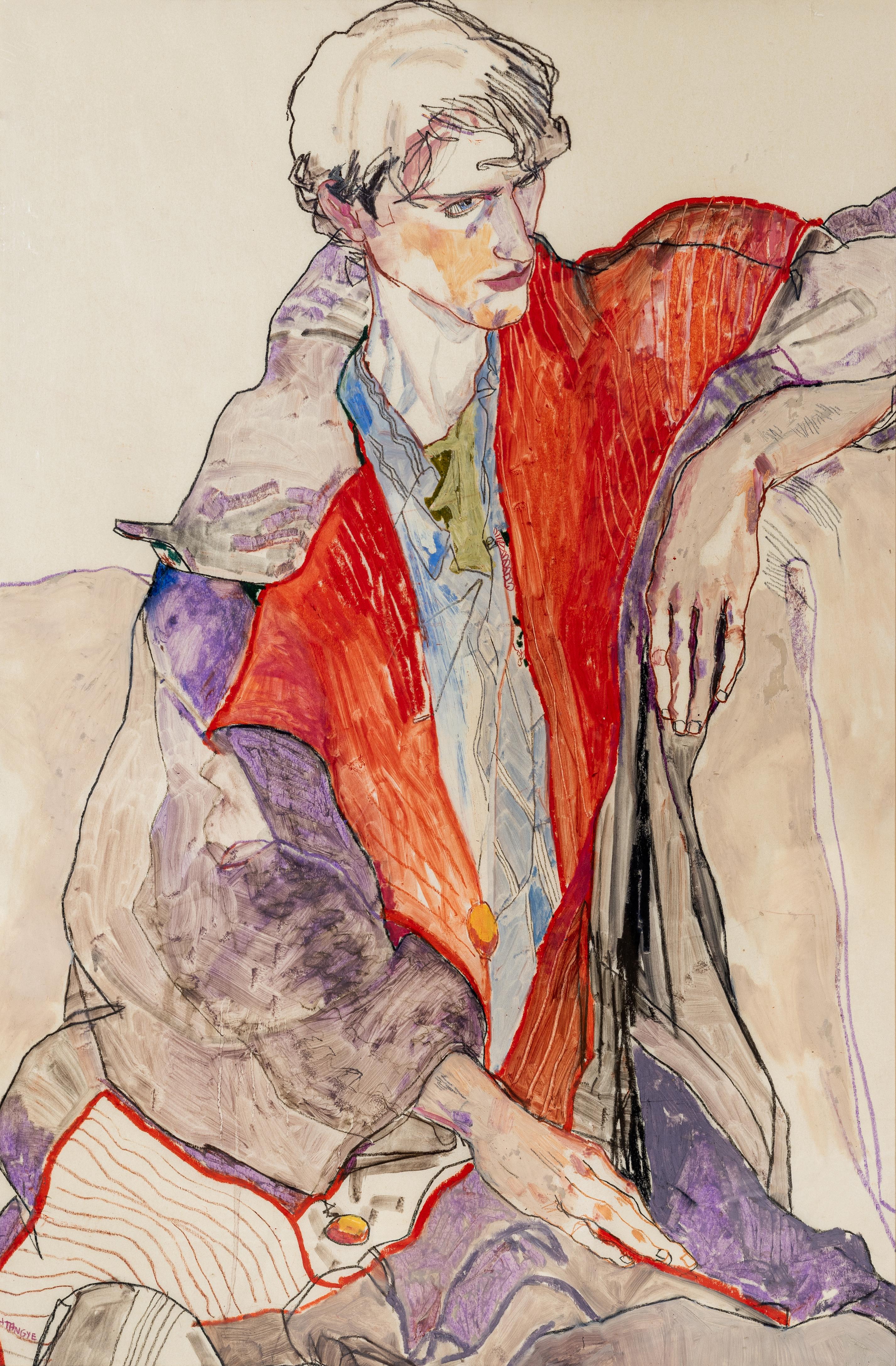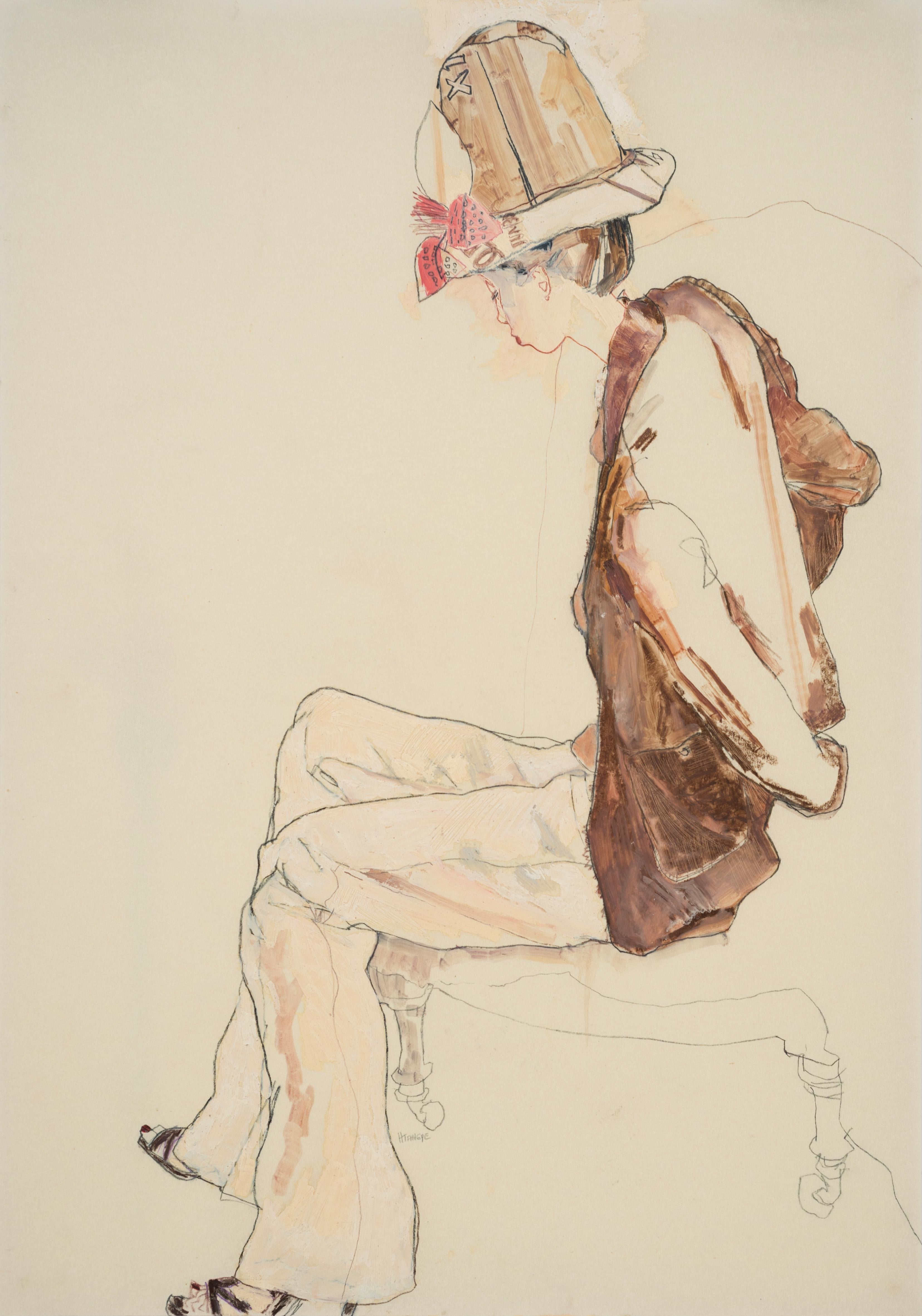Items Similar to An eastern market tent, Nile Valley
Want more images or videos?
Request additional images or videos from the seller
1 of 11
Augustus Osborne LamploughAn eastern market tent, Nile Valley1914
1914
About the Item
The orientalist painting by Lamplough depicts a tent market which is located right along the verdant waters of the Nile. Camels with merchants take up the foreground of the image near a shade canopy tied off to two palm trees. There are buildings near the water, casting a small amount of shade on the busy market due to the hour of the day. The sky is piercingly blue, while the market, the sand, and the camels are all softly creamy in tone. One immediately feels the expansiveness and beauty of the desert while also being attracted to the welcoming bosom of the market with its promise of comfort, water, and shade.
Dimensions:
Sight: 19" x 14" (48 cm x 35 cm)
Frame: 27.5" x 22.5" (70 cm x 57 cm)
Lamplough was born in Manchester and studied at the Chester School of Art. He became a lecturer at Leeds School of Art having travelled and painted scenes in Europe, the Middle East & north Africa. He is perhaps best known for his desert scenes and views of Arab towns and cities. An Excellent watercolor artist he exhibited his work at the Fine Art Society, London, Royal Academy and the Walker Art Gallery, Liverpool, amongst others.
- Creator:Augustus Osborne Lamplough (1877 - 1930, British)
- Creation Year:1914
- Dimensions:Height: 22.5 in (57.15 cm)Width: 27.5 in (69.85 cm)Depth: 3 in (7.62 cm)
- More Editions & Sizes:19" x 14"Price: $4,750
- Medium:
- Period:
- Condition:
- Gallery Location:Los Angeles, CA
- Reference Number:1stDibs: LU2080212335482
About the Seller
No Reviews Yet
Vetted Seller
These experienced sellers undergo a comprehensive evaluation by our team of in-house experts.
1stDibs seller since 2022
- ShippingRetrieving quote...Ships From: Los Angeles, CA
- Return PolicyA return for this item may be initiated within 3 days of delivery.
More From This SellerView All
- L'AuroraBy (After) Guido ReniLocated in Los Angeles, CAA monumental 19th century Italian oil painting on canvas. Titled: Aurora, after Guido Reni. Presented in the original carved gilt-wood frame. Guido Reni’s masterpiece L’Aurora was executed in 1614, and the striking image is as powerful today as it would have been to a viewer at the beginning of the 17th Century. Aurora, the Roman goddess of dawn, ushers in the day by leading Apollo, the god of light...Category
19th Century Baroque Figurative Paintings
MaterialsOil
- Figures on a PierBy Mischa KallisLocated in Los Angeles, CA‘Figures on a Pier’ - an original impressionist oil on canvas by Mischa Kallis (1903-1987) exudes the feeling of hope; calm washes over the viewer upon first glance. This piece focus...Category
Mid-20th Century Impressionist Figurative Paintings
MaterialsOil
- Tres DalisBy Miguel Garcia (Marques de Jadraque)Located in Los Angeles, CAMarqués de Jadraque’s ‘Tres Dalís’ is a large, original abstract oil on canvas painting that depicts several versions of the artist Salvador Dalí looking at...Category
1980s Abstract Abstract Paintings
MaterialsCanvas, Oil
- Le Port de Taumeck en FranceBy Lelia PissarroLocated in Los Angeles, CALe port De Taumeck en France is an exquisite oil painting on canvas by Lelia Pissarro, created in the impressionist style. The artwork beautifully captures the scenic port of Taumeck...Category
1980s Impressionist Landscape Paintings
MaterialsCanvas, Oil
- DuckBy Leo SewellLocated in Los Angeles, CAA wonderful Mixed media sculpture of a duck by the noted Philadelphia artist Leo Sewell. This is an early example from the Master of found objects. He worked with recycled objects to...Category
20th Century Modern Mixed Media
MaterialsMixed Media
- Quai des menetriers a brugesBy Camille PissarroLocated in Los Angeles, CA"Quai des Ménétriers à Bruges" is a remarkable etching created by the renowned French Impressionist artist, Camille Pissarro. This exquisite artwork captures the beauty and charm of ...Category
Late 19th Century Nude Prints
MaterialsAquatint, Etching
You May Also Like
- The Abduction of the Sabine Women , a Renaissance drawing by Biagio PupiniLocated in PARIS, FRThis vigorous drawing has long been attributed to Polidoro da Caravaggio: The Abduction of the Sabine Women is one of the scenes that Polidoro depicted between 1525 and 1527 on the façade of the Milesi Palazzo in Rome. However, the proximity to another drawing inspired by this same façade, kept at the Ecole des Beaux-Arts, and to other drawings inspired by Polidoro kept at the Musée du Louvre, leads us to propose an attribution to Biagio Pupini, a Bolognese artist whose life remains barely known, despite the abundant number of drawings attributed to him. 1. Biagio Pupini, a Bolognese artist in the light of the Roman Renaissance The early life of Biagio Pupini, an important figure of the first half of the Cinquecento in Bologna - Vasari mentions him several times - is still poorly known. Neither his date of birth (probably around 1490-1495) nor his training are known. He is said to have been a pupil of Francesco Francia (1450 - 1517) and his name appears for the first time in 1511 in a contract with the painter Bagnacavallo (c. 1484 - 1542) for the frescoes of a church in Faenza. He then collaborated with Girolamo da Carpi, at San Michele in Bosco and at the villa of Belriguardo. He must have gone to Rome for the first time with Bagnacavallo between 1511 and 1519. There he discovered the art of Raphael, with whom he might have worked, and that of Polidoro da Caravaggio. This first visit, and those that followed, were the occasion for an intense study of ancient and modern art, as illustrated by his abundant graphic production. Polidoro da Caravaggio had a particular influence on the technique adopted by Pupini. Executed on coloured paper, his drawings generally combine pen, brown ink and wash with abundant highlights of white gouache, as in the drawing presented here. 2. The Abduction of the Sabine Women Our drawing is an adaptation of a fresco painted between 1525 and 1527 by Polidoro da Caravaggio on the façade of the Milesi Palace in Rome. These painted façades were very famous from the moment they were painted and inspired many artists during their stay in Rome. These frescoes are now very deteriorated and difficult to see, as the palace is in a rather narrow street. The episode of the abduction of the Sabine women (which appears in the centre of the photo above) is a historical theme that goes back to the origins of Rome and is recounted both by Titus Livius (Ab Urbe condita I,13), by Ovid (Fasti III, 199-228) and by Plutarch (II, Romulus 14-19). After killing his twin brother Romus, Romulus populates the city of Rome by opening it up to refugees and brigands and finds himself with an excess of men. Because of their reputation, none of the inhabitants of the neighbouring cities want to give them their daughters in marriage. The Romans then decide to invite their Sabine neighbours to a great feast during which they slaughter the Sabines and kidnap their daughters. The engraving made by Giovanni Battista Gallestruzzi (1618 - 1677) around 1656-1658 gives us a good understanding of the Polidoro fresco, allowing us to see how Biagio Pupini reworked the scene to extract this dynamic group. With a remarkable economy of means, Biagio Pupini takes over the left-hand side of the fresco and depicts in a very dense space two main groups, each consisting of a Roman and a Sabine, completed by a group of three soldiers in the background (which seems to differ quite significantly from Polidoro's composition). The balance of the drawing is based on a very strongly structured composition. The drawing is organised around a median vertical axis, which runs along both the elbow of the kidnapped Sabine on the left and the foot of her captor, and the two main diagonals, reinforced by four secondary diagonals. This diamond-shaped structure creates an extremely dynamic space, in which centripetal movements (the legs of the Sabine on the right, the arm of the soldier on the back at the top right) and centrifugal movements (the arm of the kidnapper on the left and the legs of the Sabine he is carrying away, the arm of the Sabine on the right) oppose each other, giving the drawing the appearance of a whirlpool around a central point of support situated slightly to the left of the navel of the kidnapper on the right. 3. Polidoro da Caravaggio, and the decorations of Roman palaces Polidoro da Caravaggio was a paradoxical artist who entered Raphael's (1483 - 1520) workshop at a very young age, when he oversaw the Lodges in the Vatican. Most of his Roman work, which was the peak of his career, has disappeared, as he specialised in facade painting, and yet these paintings, which are eminently visible in urban spaces, have influenced generations of artists who copied them abundantly during their visits to Rome. Polidoro Caldara was born in Caravaggio around 1495-1500 (the birthplace of Michelangelo Merisi, known as Caravaggio, who was born there in 1571), some forty kilometres east of Milan. According to Vasari, he arrived as a mason on the Vatican's construction site and joined Raphael's workshop around 1517 (at the age of eighteen according to Vasari). This integration would have allowed Polidoro to work not only on the frescoes of the Lodges, but also on some of the frescoes of the Chambers, as well as on the flat of Cardinal Bibiena in the Vatican. After Raphael's death in 1520, Polidoro worked first with Perin del Vaga before joining forces with Maturino of Florence (1490 - 1528), whom he had also known in Raphael's workshop. Together they specialised in the painting of palace façades. They were to produce some forty façades decorated with grisaille paintings imitating antique bas-reliefs. The Sack of Rome in 1527, during which his friend Maturino was killed, led Polidoro to flee first to Naples (where he had already stayed in 1523), then to Messina. It was while he was preparing his return to the peninsula that he was murdered by one of his assistants, Tonno Calabrese, in 1543. In his Vite, Vasari celebrated Polidoro as the greatest façade decorator of his time, noting that "there is no flat, palace, garden or villa in Rome that does not contain a work by Polidoro". Polidoro's facade decorations, most of which have disappeared as they were displayed in the open air, constitute the most important lost chapter of Roman art of the Cinquecento. The few surviving drawings of the painter can, however, give an idea of the original appearance of his murals and show that he was an artist of remarkable and highly original genius. 4. The façade of the Milesi Palace Giovanni Antonio Milesi, who commissioned this palace, located not far from the Tiber, north of Piazza Navona, was a native of the Bergamo area, like Polidoro, with whom he maintained close friendly ties. Executed in the last years before the Sack of Rome, around 1526-1527, the decoration of Palazzo Milesi is considered Polidoro's greatest decorative success. An engraving by Ernesto Maccari made at the end of the nineteenth century allows us to understand the general balance of this façade, which was still well preserved at the time. The frescoes were not entirely monochrome, but alternated elements in chiaroscuro simulating marble bas-reliefs and those in ochre simulating bronze and gold vases...Category
16th Century Old Masters Figurative Drawings and Watercolors
MaterialsInk, Gouache, Pen
- Giorgio (Two figures, pink & blue), Mixed media on Pergameneta parchmentBy Howard TangyeLocated in London, GBHoward Tangye (b.1948, Australia) has been an influential force in fashion for decades. Lecturing at London’s Central Saint Martins for 35 years, including 16 years as head of BA Wom...Category
2010s Contemporary Figurative Paintings
MaterialsPaint, Paper, Parchment Paper, Charcoal, Crayon, Oil Crayon, Oil Pastel,...
- Jake II (Red coat), Mixed media on Pergameneta parchmentBy Howard TangyeLocated in London, GBHoward Tangye (b.1948, Australia) has been an influential force in fashion for decades. Lecturing at London’s Central Saint Martins for 35 years, including 16 years as head of BA Wom...Category
2010s Contemporary Figurative Paintings
MaterialsPaint, Paper, Parchment Paper, Charcoal, Crayon, Oil Crayon, Oil Pastel,...
- Tom Cawson (Sitting - Hand on Head), Mixed media on grey cardboardBy Howard TangyeLocated in London, GBHoward Tangye (b.1948, Australia) has been an influential force in fashion for decades. Lecturing at London’s Central Saint Martins for 35 years, including 16 years as head of BA Wom...Category
21st Century and Contemporary Contemporary Figurative Paintings
MaterialsOther Medium, Paint, Graphite, Color Pencil, Carbon Pencil, Pencil, Pen,...
- Maria Nishio (Profile - Browns), Mixed media on Pergamenata parchmentBy Howard TangyeLocated in London, GBHoward Tangye (b.1948, Australia) has been an influential force in fashion for decades. Lecturing at London’s Central Saint Martins for 35 years, including 16 years as head of BA Wom...Category
2010s Contemporary Figurative Drawings and Watercolors
MaterialsOther Medium, Paint, Paper, Parchment Paper, Chalk, Charcoal, Crayon, Oi...
- Matthew (Two Figures, Overlapping), Mixed media on ochre parchmentBy Howard TangyeLocated in London, GBHoward Tangye (b.1948, Australia) has been an influential force in fashion for decades. Lecturing at London’s Central Saint Martins for 35 years, including 16 years as head of BA Wom...Category
2010s Contemporary Figurative Paintings
MaterialsPaint, Paper, Parchment Paper, Charcoal, Crayon, Oil Crayon, Oil Pastel,...
Recently Viewed
View AllMore Ways To Browse
Marguerite Callet-Carcano On Sale
Maurice Berdon On Sale
Augusta Hoffman Studio
Augusta Hoffman
Bar Cart Nyc
Blue Milk Paint Farm Table
Bo Bartlett On Sale
Broncia Koller
Bror Julius Olsson Nordfeldt On Sale
Buford Crossland
C. Harry Allis On Sale
Cecil Wray Goodchild
Charles Paul Gruppe On Sale
Chinese Figurative Rug
Claudio Bravo Pencil
Concetta Scaravaglione
Constantin Ernest Adolphe Hyacinthe Guys On Sale
Craig Rubadoux





